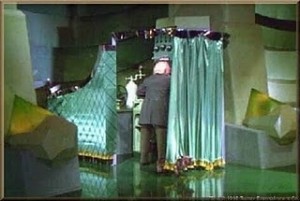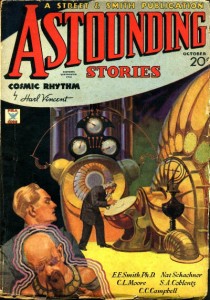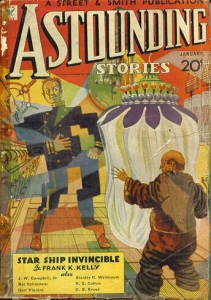Imagine if you will, that it is 1938 and you are a movie set designer looking for visual inspirations for a film about to be shot at MGM studios. A portion of the story being made into the movie is set in a fictional land where there is a city of small people and another capitol city where everything is green, excuse me, emerald in color.
I have no idea whose concept it was to make the Wizard’s wizarding machine look the way it does in the film. The list of possible creators of the concept includes, Arnold A. Gillespie, the creator of the movie’s special effects; his assistant Don Trumbull; Edwin B. Willis, the movie’s set designer; or Cedric Gibbons, the movie’s art director along with William A. Horning, who with his staff designed and built the sixty-five sets used in the film, along with a variety of special properties, from moving talking trees to the Wicked Witch’s giant hourglass. But I wonder if I may have found one of the designer’s inspirations.
While visually strolling through a website called Galactic Central looking at magazine covers for early science fiction pulp periodicals, I was surprised to see the above cover illustration from the October 1934 issue of Astounding Stories that reminded me of the Wizard’s inner sanctum from MGM’s 1939 movie, The Wizard of Oz. Even the frock-coated man manipulating the machine is reminiscent of Frank Morgan’s Wizard character, although the Wizard has neither a mustache or a beard. Astounding Stories began publishing in 1930 specializing in action-adventure stories; by 1938 it had undergone a variety of name changes becoming Astounding Science-Fiction.* The earliest publisher of the magazine, Clayton, employed the Polish born illustrator Hans Waldemar Wessolowski, known as H. W. Wesso, to produce most of the magazine’s covers. Wesso continued to contribute covers to the new publisher Street & Smith when it began again to produce the magazine later in 1933. By the middle of 1934, Astounding’s circulation is estimated to have reached 50,000 readers.**
Clearly if you are designing a futuristic Wizard’s machine you need to show a variety of lights, dials, switches, and buttons. The October Astounding cover is even more fanciful and futuristic than the movie Wizard’s control booth. A few months later another Astounding cover details another advanced machine, this one cloaked by a generous billowing curtain.
Both the October 1934 and January 1935 covers for Astounding Stories were the work of Howard V. Brown, who was Kentucky-born and trained at the School of the Art Institute of Chicago.*** In the October cover illustration you can see that the edges of the human’s eyes are lined and accentuated with black or dark brown paint. This technique gives the character’s eyes more intensity and apparent focus, similar to the characters in Fritz Lang’s 1927 movie Metropolis.
My favorite part of the October 1934 cover for Astounding, is the gigantic dial control over which the mad scientist bends. The dial rests a top a large copper bowl that looks like a tympani drum base, also known as a kettledrum. It makes me wonder if you could have thumped the dial control surface, would the unit have thrummed with a deep base drum sound? Which of course brought to my mind the loud vibrating voice of the Wizard projected from above a throne accompanied by roaring plumes of fire, “I am Oz, the great and powerful. Who are you?” **** Now isn’t that an astounding possibility?
* In 1960 its name changed again to Analog Science Fact & Fiction.
** Mike Ashley, The Time Machines: The Story of Science-Fiction Pulp Magazines from the beginning to 1950 (Liverpool: Liverpool University Press, 2000): 85.
*** Vincent Di Fate, Infinite Worlds: The Fantastic Visions of Science Fiction Art (London: Virgin Books, 1997): 130.
**** https://www.filmsite.org/wiza3.html
April 21, 2011
By Joyce K. Schiller Curator, Rockwell Center for American Visual Studies
Norman Rockwell Museum









